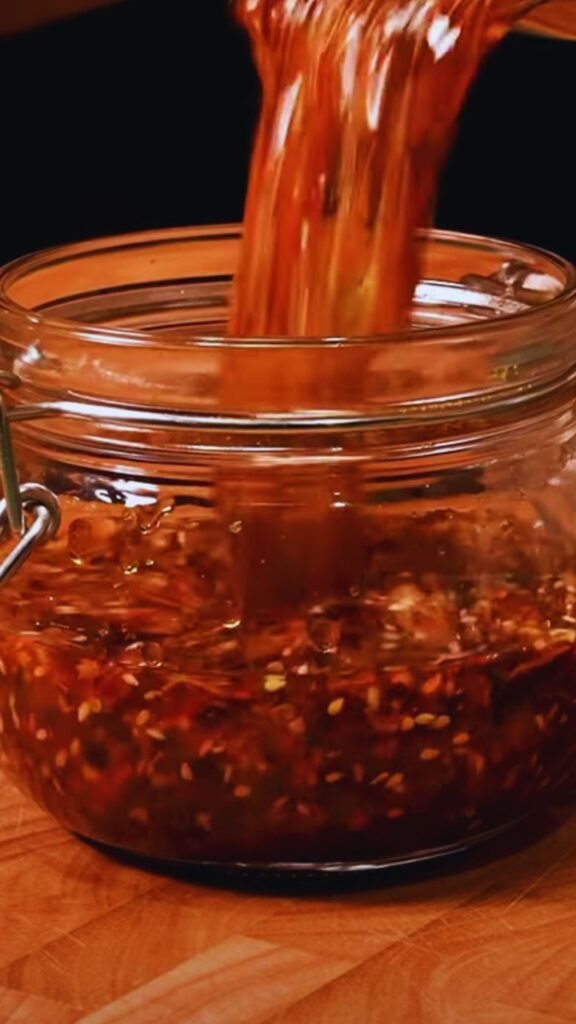There’s something magical about that moment when a spoonful of vibrant red chilli oil hits a steaming bowl of noodles or dumplings. The sizzle, the aroma, the promise of heat that makes your taste buds dance—it’s an experience that transforms an ordinary meal into something extraordinary.
I’ve spent years perfecting my crispy chilli oil recipe, and today I’m thrilled to share it with you. This isn’t just any condiment; it’s a labor of love that combines aromatic spices, quality oils, and the perfect balance of heat to create what many of my friends now refer to as “liquid gold.”
What sets this recipe apart is the crispy element—those delightful bits of fried garlic, shallots, and chilli flakes that add texture and intensify the flavor profile. Whether you’re a heat seeker or just dipping your toes into the world of spicy condiments, this crispy chilli oil recipe can be customized to suit your tolerance while still delivering incredible depth of flavor.
The History and Significance of Chilli Oil
Chilli oil has deep roots in Asian cuisine, particularly in Chinese, Korean, and Japanese cooking traditions. Originally created as a way to preserve chillies and add flavor to simple dishes, it has evolved into countless regional variations, each with its own unique blend of spices and preparation methods.
In Sichuan cuisine, for example, chilli oil (often called “red oil” or “hong you”) is a cornerstone ingredient that gives many dishes their signature numbing-spicy flavor profile when combined with Sichuan peppercorns. In Japan, “rayu” often incorporates sesame oil for a nuttier flavor, while Korean versions might include fermented soybean paste for added complexity.
What began as a humble preservation method has become a global sensation, with artisanal varieties commanding premium prices in specialty food stores. But the truth is, making exceptional crispy chilli oil at home isn’t just more economical—it’s infinitely more satisfying and allows you to tailor the flavor exactly to your preference.
The Science Behind the Sizzle
Before we dive into the recipe, let’s understand what makes crispy chilli oil so special from a culinary science perspective:
Infusion: When hot oil meets spices, it extracts fat-soluble flavor compounds, creating a deeply infused base.
Maillard Reaction: The browning of the garlic, shallots, and other aromatics produces hundreds of new flavor compounds, adding complexity.
Capsaicin Transfer: The heat compound in chillies (capsaicin) is fat-soluble, meaning it dissolves perfectly in oil, distributing its heat evenly.
Oil Temperature: The ideal temperature range for infusing spices is between 225°F and 250°F (107°C to 121°C)—hot enough to extract flavors without burning the delicate aromatics.
Understanding these principles will help you create a balanced, flavorful chilli oil with the perfect level of heat and those irresistible crispy bits.
Ingredients: The Foundation of Extraordinary Chilli Oil

The quality of your ingredients will determine the quality of your final product. Here’s what you’ll need:
For the Crispy Elements:
- 8 large cloves garlic, minced finely
- 4 medium shallots, minced finely
- 2 tablespoons finely chopped ginger
- ¼ cup crushed peanuts (optional, for added texture)
For the Chilli Base:
- ½ cup good quality chilli flakes (Korean gochugaru works wonderfully, but any will do)
- 2 tablespoons Sichuan peppercorns (for that distinctive numbing quality)
- 1 tablespoon paprika (for color and mild sweetness)
- 2 teaspoons crushed red pepper flakes (for added heat, adjust to taste)
- 1 cinnamon stick
- 3 star anise
- 2 bay leaves
- 1 tablespoon white sesame seeds
- 1 tablespoon black sesame seeds
- 1 teaspoon fennel seeds
- 1 teaspoon coriander seeds
- 1 teaspoon salt (I prefer fine sea salt)
- 1 teaspoon sugar (balances the heat)
For the Oil Base:
- 1½ cups neutral oil (grapeseed, vegetable, or peanut oil)
- 2 tablespoons sesame oil (for aroma and depth)
Optional Flavor Enhancers:
- 1 tablespoon mushroom powder (adds umami)
- 1 tablespoon fermented black beans, rinsed and chopped
- Zest of one orange (adds a surprising citrus note)
- 1 tablespoon MSG (if you enjoy that additional savory boost)
Equipment You’ll Need
For the best results, gather these tools before starting:
- Heavy-bottomed saucepan or wok
- Heat-resistant glass bowl or container (for the final product)
- Fine mesh strainer (if you prefer less crispy bits)
- Candy or deep-fry thermometer
- Wooden spoon
- Clean, sterilized jars for storage
The Method: Creating Liquid Gold
Now for the exciting part—making your crispy chilli oil! I’ve broken this down into manageable steps to ensure success.
Step 1: Prepare Your Aromatics and Spices
- Finely mince the garlic, shallots, and ginger. The finer the mince, the better they’ll crisp up. Pat them dry with paper towels to remove excess moisture.
- Toast the Sichuan peppercorns, star anise, bay leaves, cinnamon stick, fennel and coriander seeds in a dry pan over medium-low heat for 2-3 minutes, until fragrant. Let cool, then grind the Sichuan peppercorns coarsely.
- In a heat-resistant bowl, combine all the chilli flakes, ground Sichuan peppercorns, paprika, crushed red pepper flakes, salt, sugar, sesame seeds, and any optional flavor enhancers. Mix well.
Step 2: Crisp the Aromatics
- In your heavy-bottomed pan, heat the neutral oil to approximately 240°F (115°C).
- Add the minced garlic first, stirring constantly to prevent burning. Cook until it just begins to turn golden, about 2-3 minutes.
- Add the shallots and ginger, continuing to stir. Cook until everything is golden and crispy, about 4-5 minutes more.
- If using crushed peanuts, add them now and cook for another minute.
- Remove from heat when the aromatics are golden brown but not dark brown—they’ll continue cooking in the residual heat.
Step 3: The Magical Infusion
- Let the oil and crispy bits cool to about 225°F (107°C)—hot enough to bloom the spices but not so hot that it burns them.
- Add the star anise, bay leaves, and cinnamon stick to the oil and let steep for 5 minutes.
- Remove these larger spices with a slotted spoon.
- Carefully pour the hot oil with the crispy aromatics over your bowl of chilli flake mixture.
- Stand back as it sizzles dramatically! This moment is pure kitchen magic—the spices will foam slightly and release the most incredible aroma.
- Stir gently to ensure all the spices are submerged.
- Allow to cool for 5 minutes, then stir in the sesame oil for that final aromatic touch.
Step 4: Rest and Mature
- Let the oil come to room temperature, uncovered.
- Once cooled, transfer to sterilized jars.
- While you can use it immediately, the flavor improves dramatically after 24 hours as the spices continue to infuse.
Flavor Variations: Making It Your Own
One of the joys of making your own crispy chilli oil is the ability to customize it. Here are some of my favorite variations:
Extra Numbing (Mala Style)
- Double the Sichuan peppercorns
- Add ½ teaspoon ground white pepper
Smoky Version
- Replace half the chilli flakes with smoked paprika
- Add 1 teaspoon of chipotle powder
Herbaceous Twist
- Add 1 tablespoon of dried thyme
- Infuse with 2 sprigs of rosemary (remove before jarring)
Sweet and Spicy
- Increase sugar to 1 tablespoon
- Add ¼ teaspoon of five-spice powder
Extra Crispy
- Add 2 tablespoons of panko breadcrumbs to the oil when frying the aromatics
- Increase the amount of garlic and shallots by 50%
How to Store Your Liquid Gold

Proper storage is essential for maintaining the quality and extending the shelf life of your crispy chilli oil:
- Store in clean, airtight glass containers
- Keep at room temperature for up to 1 month
- Refrigerate for extended storage (up to 3 months)
- Always use clean utensils when scooping out the oil
- If refrigerated, allow to come to room temperature before using to enjoy the full flavor profile
Note: Some separation is natural—simply stir before using. A cloudy appearance when refrigerated is also normal and will clear when brought to room temperature.
Nutrition Information
For those who like to keep track of nutritional content, here’s a breakdown per tablespoon serving:
| Nutrient | Amount |
|---|---|
| Calories | 120 |
| Total Fat | 13g |
| Saturated Fat | 1.5g |
| Unsaturated Fat | 11.5g |
| Sodium | 80mg |
| Total Carbohydrate | 2g |
| Dietary Fiber | 0.5g |
| Sugars | 0.5g |
| Protein | 0.5g |
| Vitamin A | 8% DV |
| Vitamin C | 2% DV |
| Calcium | 1% DV |
| Iron | 2% DV |
*Values are approximate and will vary based on specific ingredients used.
Troubleshooting Common Issues
Even experienced cooks can encounter challenges. Here are solutions to common problems:
| Issue | Possible Cause | Solution |
|---|---|---|
| Burnt taste | Oil temperature too high | Use a thermometer to monitor temperature; keep below 250°F |
| Not spicy enough | Chilli flakes too old or mild | Use fresher chilli flakes or add more; consider adding cayenne |
| Too spicy | Too much chilli or particularly hot variety | Balance with more oil; add a bit more sugar |
| Not enough crispy bits | Aromatics cut too coarsely or had excess moisture | Mince finely and pat dry before frying |
| Oil separates too much | Natural separation | Stir before using; consider adding an emulsifier like mustard powder (½ tsp) |
| Molds quickly | Contamination during preparation or storage | Ensure all utensils and jars are completely clean; store properly |
Ways to Use Your Crispy Chilli Oil

Now that you’ve created this versatile condiment, here are my favorite ways to use it:
Traditional Applications:
- Drizzled over dumplings, bao, or wontons
- Stirred into noodle soups or ramen
- Mixed with black vinegar for a perfect dumpling dipping sauce
- Spooned over steamed or stir-fried vegetables
- Added to fried rice for a spicy kick
Unexpected Delights:
- Swirled into hummus or yogurt dips
- Brushed onto grilled corn on the cob
- Drizzled over scrambled eggs or avocado toast
- Used to finish pizza (particularly white pizzas)
- Mixed into mayonnaise for an incredible sandwich spread
- Tossed with popcorn for a gourmet movie night treat
- Drizzled over vanilla ice cream (trust me on this one!)
Cooking Applications:
- Use as a starting oil for stir-fries
- Brush onto proteins before grilling
- Add to marinades for extra depth
- Swirl into soups and stews just before serving
- Use in salad dressings in place of plain oil
Serving Suggestions
For an impressive spread that showcases your homemade chilli oil, try these combinations:
Dumplings & Dipping Party
- Assorted dumplings (store-bought saves time)
- Small bowls of crispy chilli oil
- Black vinegar
- Soy sauce
- Sliced scallions and cilantro for garnish
- Cucumber salad for cooling contrast
Noodle Bar Experience
- Various cooked noodles (ramen, udon, rice noodles)
- Crispy chilli oil
- Soft-boiled eggs
- Sliced vegetables
- Various proteins
- Broths on the side
- Fresh herbs for garnish
Refreshing Accompaniments
- Chilled cucumber salad
- Citrus-forward mocktails
- Sparkling water with lime
- Iced jasmine tea
Gifting Your Creation
Homemade crispy chilli oil makes an exceptional gift. For gift-worthy presentation:
- Use decorative glass jars with tight-fitting lids
- Create custom labels with the date made and usage suggestions
- Include a recipe card for a dish that pairs well with the oil
- Add a small wooden spoon or drizzler
- Consider creating a gift basket with complementary items like noodles, dumplings, or a beautiful serving bowl
Sustainability Notes
To make your chilli oil practice more environmentally friendly:
- Source ingredients locally when possible
- Use organic spices when available
- Repurpose glass jars rather than buying new ones
- Consider growing your own chillies and herbs
- Save vegetable scraps for stock rather than discarding them
- Compost applicable food waste from the process
Questions & Answers
Q: How long will homemade crispy chilli oil last? A: When stored properly in a clean, airtight container, homemade crispy chilli oil can last up to 1 month at room temperature or 3 months refrigerated. Watch for any signs of mold or off smells, which would indicate spoilage.
Q: Can I make a milder version that still has good flavor? A: Absolutely! Reduce the amount of chilli flakes by half and increase the paprika to maintain the beautiful red color. You can also de-seed your chillies before drying and crushing them, as most of the heat resides in the seeds and membranes.
Q: Why did my garlic turn blue in the oil? A: This is a chemical reaction between sulfur compounds in garlic and certain acids. While alarming in appearance, it’s completely safe to eat. To minimize this reaction, use very fresh garlic and make sure your oil isn’t too hot when adding the garlic.
Q: Is it normal for my oil to bubble and foam when I pour it over the spices? A: Yes! This is exactly what you want to see. The bubbling indicates that the moisture in the spices is evaporating, which helps release flavor compounds and contributes to the crispy texture.
Q: Can I use olive oil instead of neutral oil? A: I don’t recommend it for most of the oil base, as olive oil has a strong flavor that can compete with the spices and a lower smoke point. However, you could replace the sesame oil with a mild olive oil if needed.
Q: What’s the difference between regular chilli oil and crispy chilli oil? A: Traditional chilli oil is simply spices infused in oil, sometimes strained for a smooth result. Crispy chilli oil includes fried aromatics and sometimes additional textural elements that remain in the finished product, adding both flavor and a satisfying crunch.
Q: Can I make this without Sichuan peppercorns if I can’t find them? A: Yes. While Sichuan peppercorns add that distinctive numbing quality, you can omit them and still have a delicious chilli oil. Consider adding a pinch of black pepper and a little extra coriander to add complexity.
Q: My chilli oil isn’t as red as I’d like. What went wrong? A: The vibrant red color comes primarily from the chilli flakes and paprika. Make sure you’re using fresh, bright red chilli flakes. Adding more paprika can enhance the color without adding excessive heat.
Q: Can I reuse the larger spices like star anise and cinnamon for another batch? A: Yes! These spices can often be reused once more, especially if you dry them out after removing from the oil. They won’t be quite as potent but still contribute flavor.
Q: Is there a way to make this oil without any crispy bits for those who prefer smooth textures? A: Absolutely. You can strain the oil through a fine-mesh sieve lined with cheesecloth after it’s fully cooled. You’ll still get the infused flavor without the textural elements.
Final Thoughts
Creating your own crispy chilli oil isn’t just about adding heat to your meals—it’s about crafting a complex, versatile condiment that can elevate even the simplest dishes. There’s something deeply satisfying about seeing those vibrant red jars lining your pantry, each one representing a perfect balance of heat, aroma, and flavor that you’ve personally crafted.
I encourage you to experiment with this recipe, adjusting the spice levels and aromatics to create your own signature version. Pay attention to how the flavors develop over time, and don’t be afraid to try unconventional additions or applications.
Remember that making crispy chilli oil is both a science and an art—each batch will have its own unique character, influenced by the quality and freshness of your ingredients, the temperature of your oil, and even the environment in which it’s prepared.
The next time you’re looking to add a splash of excitement to your cooking routine, reach for your homemade crispy chilli oil and watch as it transforms the ordinary into the extraordinary. Your taste buds—and your dinner guests—will thank you.



